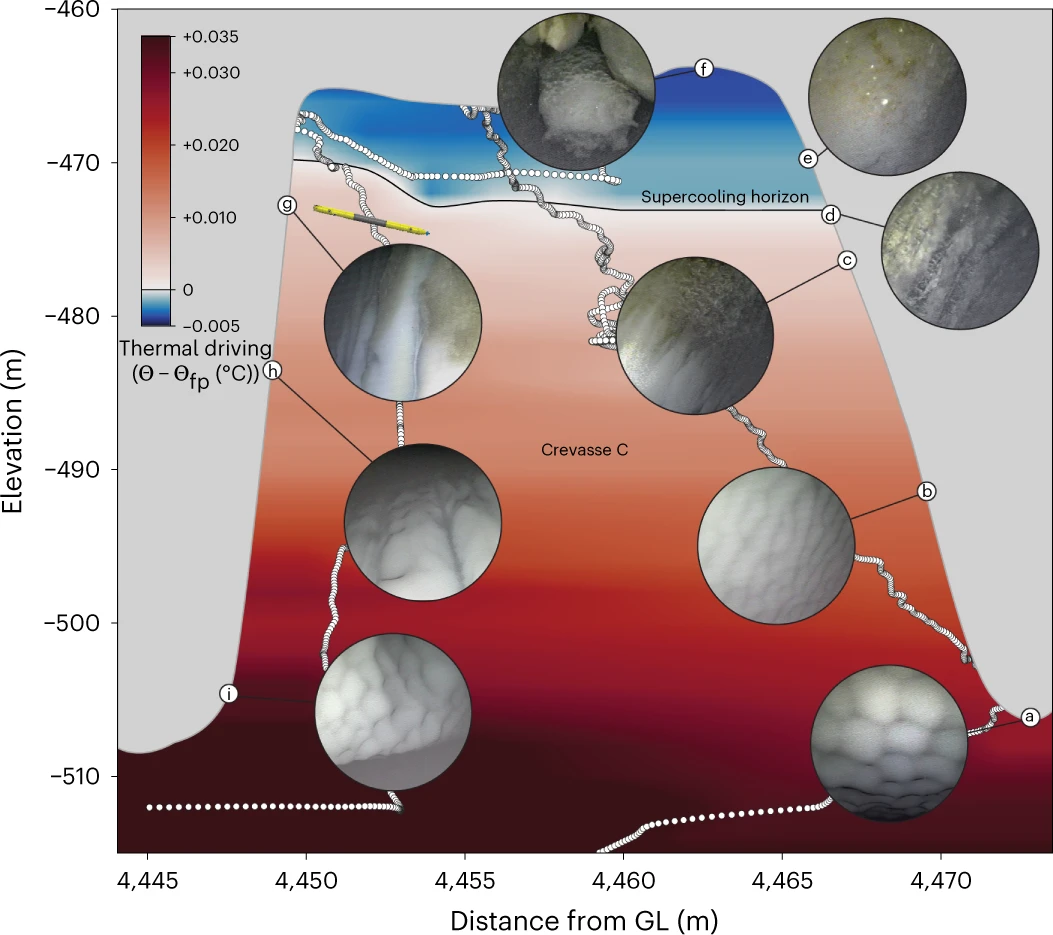March 2 () –
The cameras of the remotely operated underwater vehicle ‘Icefin’ have offered unprecedented images of a sudden change under the Antarctic ice shelf.
Atop a narrow seawater-filled crevasse at the base of Antarctica’s largest ice shelf, the smooth, turbid ice walls suddenly turned green and rougher in texture, turning to salty sea ice.
At almost 275 meters high, near where the surface of the Ross Ice Shelf meets the Kamb Ice Stream, a US-New Zealand research team recognized the change as evidence of “ice pumping”, a process never before directly observed in an ice shelf riftimportant for its stability.
“We were looking at ice that had melted less than 30 meters down, flowed into the rift and refroze,” he explains. it’s a statement Justin Lawrence, a visiting professor at Cornell’s Center for Astrophysics and Planetary Sciences. And it all got weirder the higher we went up.”
The study, published in the journal ‘Nature Geoscience’offers an unprecedented look from the ‘Icefin’ robot inside a rift, and observations that reveal more than a century of geological processes beneath the ice shelf.
The article collects the results of a field campaign carried out in 2019 on the Kamb Ice Stream, funded by Antarctica New Zealand and led by Christina Hulbe, a professor at the University of Otago, and colleagues.
Thanks to the support of NASA’s Astrobiology Program, a research team led by Britney Schmidt, associate professor of astronomy and Earth and atmospheric sciences at Cornell University, was able to join the expedition and deploy Icefin. The Schmidt Laboratory for Planetary Habitability and Technology has been developing the ‘Icefin’ for nearly a decade, starting at the Georgia Institute of Technology.
Combined with recently published research on the rapidly evolving Thwaites Glacier, explored that same season by a second ‘Icefin’ vehicle, The research is expected to improve models of sea level rise by providing the first high-resolution views of ice-ocean-seafloor interactions in contrasting glacial systems of the West Antarctic Ice Sheet.
Thwaites, exposed to warm ocean currents, is one of the most unstable glaciers on the continent. The Kamb Ice Current, where the ocean is very cold, has been stagnant since the late 19th century. Kamb currently makes up for part of the West Antarctic ice loss, but if it is reactivated it could increase the region’s contribution to sea level rise by 12%.
“Antarctica is a complex system, and it’s important to understand both ends of the spectrum: systems that are already experiencing rapid change, and calmer systems where future change poses a risk,” Schmidt says. Thwaites helps us learn more.”
NASA funded the development of the ‘Icefin’ and Kamb exploration to expand exploration of the oceans beyond Earth. Sea ice like that found in the rift may be an analogue of conditions on Jupiter’s icy moon Europa, the target of NASA’s Europa Clipper orbital mission scheduled for launch in 2024. Subsequent landing missions could one day directly search for microbial life in the ice.
The ‘Icefin’ carries a complete suite of oceanographic instruments in a modular frame more than 3 meters long and less than 25 centimeters in diameter. The New Zealand team introduced it onto the ice shelf through a hole drilled with hot water.
During three dives over three miles near the grounding area where Kamb transitions to Ross’s floating platform, he mapped five rifts — ascending one of them — and the seafloor, while recording water conditions, including temperature, pressure, and salinity.
The team observed various features of the ice that provide valuable information about water mixing and melt rates. Among them, golf ball-like dimples, ripples, vertical troughs, and the more “weird” formations near the top of the crack: ice globes and brinicle-like finger-like protrusions.
According to the researchers, the ice pumping observed in the rift likely contributes to the relative stability of the Ross Ice Shelf — the world’s largest by area, the size of France — compared to the Thwaites Glacier.
“It’s a way that these large ice shelves can protect and heal themselves,” said Peter Washam, a polar oceanographer on Icefin’s science team and second author of the paper. “Much of the melting that occurs on the depths, close to the bottom line, that water refreezes and accumulates at the bottom of the ice in the form of sea ice“.
On the seafloor, the Icefin mapped parallel sets of ridges that the researchers say are impressions left by cracks in the ice shelf, and a 150-year record of activity since the Kamb Current stalled. As its bottom line receded, the ice shelf thinned, causing the cracks to rise. Over time, the slow movement of the ice pushed the cracks out to sea.
“We can look at the features of the seafloor and relate them directly to what we saw at the ice bed,” said Lawrence, the paper’s lead author and current program manager and planetary scientist at Honeybee Robotics. We can, in a way, rewind the process.”






![[Img #74662]](https://thelatestnews.world/wp-content/uploads/2024/12/Organisms-with-the-shortest-life-150x150.jpg)






![[Img #74662]](https://thelatestnews.world/wp-content/uploads/2024/12/Organisms-with-the-shortest-life-300x200.jpg)

